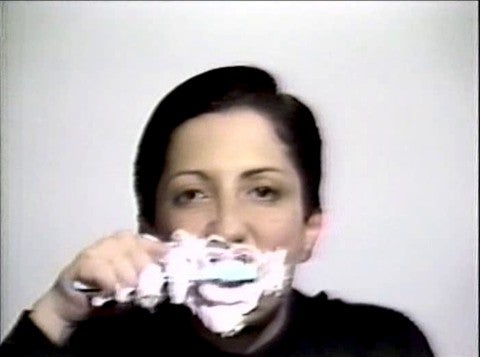Born and based in São Paulo, Lenora de Barros has investigated the intersections of art, the body, and language for more than fifty years. The visual artist and poet began her career in the 1970s after graduating from the University of São Paulo with a BA in linguistics. Interested in the systems of different languages and influenced by Concrete art and poetry—which focuses on expression through the structures and graphic patterns of words, letters, and symbols rather than their conventional meanings—de Barros created early experimental works that would inform a range of videos, performances, and sound installations later in her career.
In the 1970s, she began creating visual poetry, constructing poems from photographic sequences of performative acts, rather than words. Her first visual poem, Poema (Poem) (1979), is a sensual yet tension-filled series picturing her tongue interacting with and ensnared by the keys and levers of a typewriter. It alludes to the different, entangled ways in which language is communicated: from the mouth, by the hands, and through the machine, in verbal and written forms of expression. It also recalls the twenty-one-year military dictatorship in Brazil (1964–85), which de Barros experienced in its entirety. It was a period of intense repression and abuses against political dissidents. Arrests, imprisonments, kidnapping, censorship, torture, killings, and disappearances stifled freedom of speech in the country. The danger and precarity of life under a dictatorship necessitated coded, alternative forms of communication to avoid the violent repercussions of openly communicating anger or disapproval of the government, which is intensely suggested in Poema.
De Barros spent much of the 1980s writing poetry and published her first book, Onde Se Ve (Where It’s Seen), in 1983. She also wrote a weekly column in the newspaper Jornal de Tarde (São Paulo), which she considered a lab for testing out new artistic forms and concepts. Titled “…Umas (Some),” from 1993 to 1996, the feature included photo-performances, poems, and poetic texts, which serve as the basis for later artworks. The 1990s also saw de Barros’s creation of “ping-poems”—ping pong balls inscribed with poetic phrases—which would recur in her work in the following two decades. In 1990, she made Poesia é coisa de nada (Poetry is Nothing), an installation of five thousand ping pong balls scattered across the floor with the titular phrase stamped on each. De Barros then began bouncing the balls to introduce a sonic element to her work in 1994. With the objects, she was able to inject a sense of playfulness into her work while also addressing serious concerns. In Volume Morto (Dead Volume) (2015), for instance, one by one, numerous balls drop from a large overhead water container and into an empty swimming pool as a commentary on the widespread drought occurring in Brazil at the time.
Humor, irony, and playfulness are qualities that run through de Barros’s body of work, mitigating the trenchancy of her critical commentary on social and cultural dilemmas as well as proposing unexpected linkages between her practice and that of other artists associated with modern art movements, such as Pop art, Fluxus, Conceptual art, and body art, including George Segal (1924–2000). De Barros first saw Pop artist Segal’s work—deadpan white plaster figures expressive of the anonymity and psychology of the individual within mass culture—at the São Paulo Biennial while she was a college student in 1967. She later would see the potential in playing with Segal’s forms, combining the banality of daily life with the fantastical of her creative ingenuity.
The video Homenagen a George Segal (Homage to George Segal) (1984) is derived from not only Segal’s sculpture but also de Barros’s own art, specifically a black-and-white photo-performance created in 1975 with the same title and similar imagery. De Barros is in constant dialogue with her previous works and often cannibalizes her own art, creating new pieces developed from the themes of early photo-performance into texts, videos, and installations. She has explained “a feeling, sometimes, that each work is never completely ‘finished,’ always continues in another, and so on, reaching (I hope!), new meanings….” Thus, in 1984 she made her first foray into video art by mining her oeuvre.
The video is a sequence of jump cuts, juxtaposing scenes of de Barros calmly brushing her teeth with views of her face and head gradually covered with paste that creates a white sculptural mask reminiscent of Segal’s sculptures. While absurd and seemingly nonsensical, Homage also is poetically and playfully resonant. De Barros’s video alludes to masking, as a single face is exposed, concealed, and shifting in between. What was previously familiar is made strange and fluid. Through the manipulation of materials—spreading paste and cutting video—Homage is therefore a refusal of fixed meanings and an insistence on the evolution and re-interpretation of art, the body, and language. —Kanitra Fletcher

